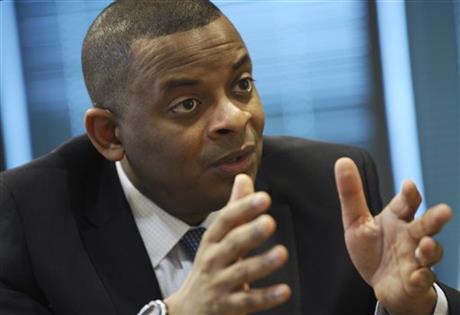
By JOAN LOWY
Transportation Secretary Anthony Foxx speaks during an interview with the Associated Press at the Transportation Department in Washington, Tuesday, Jan. 14, 2014. Americans spend a total of 600,000 years stuck in traffic every year. The nation has about 100,000 bridges old enough for Medicare. And a recent global ranking put the United States’ infrastructure in 25th place, just behind Barbados. But Foxx says he sees signs the nation may finally be ready to tackle its “infrastructure deficit.”(AP Photo/Susan Walsh)
Anthony Foxx
Transportation Secretary Anthony Foxx speaks during an interview with the Associated Press at the Transportation Department in Washington, Tuesday, Jan. 14, 2014. Americans spend a total of 600,000 years stuck in traffic every year. The nation has about 100,000 bridges old enough for Medicare. And a recent global ranking put the United States’ infrastructure in 25th place, just behind Barbados. But Foxx says he sees signs the nation may finally be ready to tackle its “infrastructure deficit.” (AP Photo/Susan Walsh)
Prev 1 of 2 Next
WASHINGTON (AP) — Americans spend a total of 600,000 years stuck in traffic every year. The nation has about 100,000 bridges old enough for Medicare. And a recent global ranking put the United States’ infrastructure in 25th place, just behind Barbados. But Transportation Secretary Anthony Foxx says he sees signs the nation may finally be ready to tackle its “infrastructure deficit.”
One reason for optimism is that some members of Congress are beginning to talk about specific proposals to shore up the federal Highway Trust Fund, which has been teetering on the edge of insolvency for years, Foxx told The Associated Press in an interview.
The fund pays for federal highway and transit aid, as well as many transportation safety programs. It’s funded primarily through federal gas and diesel taxes, but revenues haven’t kept pace with transportation needs. Without congressional action, the fund could start “bouncing checks” as soon as August, according to a draft of a speech Foxx plans to give to an international gathering of transportation researchers and officials in Washington on Wednesday.
Rep. Earl Blumenauer, D-Ore., recently introduced legislation to increase the federal 18.4 cents-per-gallon gas tax by 15 cents over the next three years, and then index it for inflation. It would raise about $170 million over the next decade. Sen. Barbara Boxer, D-Calif., has proposed eliminating the per-gallon gas tax and replacing it with a federal sales tax based on a percentage of the price of the gas sold.
“The more folks step up and put their ideas on the table, the more it creates the context for a solution to emerge,” Foxx said. “I consider it progress that these proposals are being put out there.” He did not, however, endorse the proposals.
The White House has been pushing a plan to overhaul corporate taxes, using billions of dollars in savings to shore up infrastructure investment for at least the next several years. The plan initially got a cool reception from congressional Republicans, but Foxx said he is encouraged that key committee chairmen in the House and Senate and other lawmakers have expressed interest in the concept.
“The interest level is very high on corporate tax reform,” said Foxx, a former Charlotte, N.C., mayor, who was sworn into office in July. He said he has spent recent months meeting with more than 70 members of Congress. “There is momentum, but there is a lot that has to happen between now and getting something done,” he said.
Transportation agencies have also begun making project dollars go farther through better technology and improved construction practices, Foxx said, citing a new kind of “warm” asphalt that doesn’t have to be heated. It may not sound like much, but the savings on just warm asphalt could tally $3.6 billion by 2020, he said. Add other efficiencies that are becoming “best practices” and the savings nationally could potentially tally tens of billions of dollars, he said.
One of his priorities, Foxx said, will be to develop a national plan that looks at changing demographics — such as the population booms some cities are experiencing, shared economic interests of certain regions, and other data — to forecast transportation needs.
“We’re trying to help create a 21st century context for decision-makers at every level,” Foxx said. “Part of our responsibility is helping us think with our heads, and not just with our hearts, about where investments will give us the best return on value.”
Foxx said he hopes to have the plan finished by the end of this year, but acknowledged the timetable is “aggressive.” Work on the last federal forecast of the country’s transportation needs started in the late 1970s, he said, and there hasn’t been another one like that since.
___



